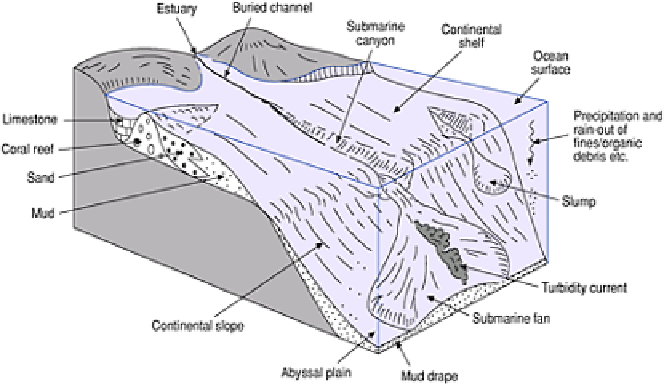Environmental Engineering Reference
In-Depth Information
generally high-energy, unstable environments. Large-calibre gravel and coarse sands are
deposited inshore in the
surf belt
and grade progressively into fine sands and muds
towards the outer shelf. The shelf is constantly reworked by waves, tides, storms and
currents which generate positive (sediment accumulation) or negative (scour)
bed forms
which reflect current velocity and direction. Giant sand waves and offshore sand/shingle
bars form a mobile shelf-bed morphology. Mud drapes represent transient fine sediment
fluxes in these environments. They are extensive only in sheltered estuaries and
epicontinental seas, or at depth. Shell debris accumulates in high-energy onshore and
offshore ridge structures, and carbonates derived from them form cement during sediment
diagenesis.
Reefs
build more permanent biogeomorphological structures. The entire shelf
assemblage is susceptible to fluctuating sea level, and onshore/offshore zones often
display relict features from both environments. The inshore continuum with the coast is
developed in Chapter 17.
Continental slopes are probably the most dynamic oceanic sedimentary environments,
responsible for transferring shelf sediments to the abyssal plains. Extended efflux from
large deltas develops fan deposits on the slope,
Figure 12.19
The general range of marine sedimentary
environments.
more commonly during times of low sea level (i.e. cold stages) when much of the shelf
becomes an extension of the coastal plain and is thus truncated. Few deltas are large
enough to feed such fans today. The Ganges-Brahmaputra fan is the most impressive and
extends over 1,500 km into the Bay of Bengal. Mass movement by slumping or
liquefaction and flow is a more widespread transfer process. Turbidity currents are low-
density debris flows, mobilized by top loading of sediment, currents or earthquakes. They
etch canyons in the slope and discharge large volumes of sediment at speeds of 20-50 km
h
−1
for 10
1-2
km beyond the continental rise.
Turbidite
sequences form the continental
rise through the coalescence of coarser, basal fans and assist in levelling the abyssal plain

